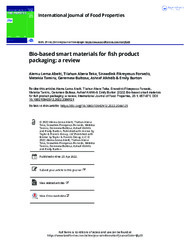| dc.contributor.author | Abelti, Alemu Lema | |
| dc.contributor.author | Teka, Tilahun A. | |
| dc.contributor.author | Forsido, Sirawdink Fikreyesus | |
| dc.contributor.author | Tamiru, Metekia | |
| dc.contributor.author | Bultosa, Geremew | |
| dc.contributor.author | Alkhtib, Ashraf | |
| dc.contributor.author | Burton, Emily | |
| dc.date.accessioned | 2022-05-27T08:16:48Z | |
| dc.date.available | 2022-05-27T08:16:48Z | |
| dc.date.issued | 2022-04-25 | |
| dc.identifier.citation | Abelti, A. L., Abera Teka, T., Fikreyesus Forsedo, S., Tamiru, M., Bultosa, G., Alkhtib, A., & Burton, E. (2022). Bio-based smart materials for fish product packaging: a review. International Journal of Food Properties, 25(1), 857-871. | en_US |
| dc.identifier.issn | 1094-2912 | |
| dc.identifier.issn | 1532-2386 | |
| dc.identifier.uri | https://doi.org/10.1080/10942912.2022.2066121 | |
| dc.identifier.uri | https://tandfonline.com/LJFP | |
| dc.identifier.uri | https://doaj.org/toc/1094-2912 | |
| dc.identifier.uri | https://hdl.handle.net/13049/470 | |
| dc.description | This is an Open Access article distributed under the terms of the Creative Commons Attribution License (http://creativecommons.org/licenses/by/4.0/), which permits unrestricted use, distribution, and reproduction in any medium, provided the original work is properly cited. | en_US |
| dc.description.abstract | Conventional packaging offers protection, containment, communication, and convenience to packaged food. The most commonly used packaging materials are petrochemical-based plastics which generate massive wastes that persist for a long time in the environment after their use. Bio-based materials are the best option to replace this synthetic plastic. This review presents the importance of packaging fish products using polysaccharides, proteins, polyhydroxyalkanoates, polylactic acids, pullulan, and xanthan gums loaded with different nanofillers and bioactive molecules. Bio-based smart materials easily decompose into carbon dioxide, methane, water, and inorganic compounds. Biopolymers can be produced from natural biomass, bio-monomers, and microorganisms. These biopolymers demonstrate excellent physiochemical, thermal, and mechanical properties when mixed or alone as fish packaging materials. Integration of nanofillers and bioactive molecules improves mechanical, gas barrier, antioxidant and antimicrobial properties of bio-based materials. Bioactive molecules like anthocyanins, betalains, curcumin, and clove oil are sensitive to pH, temperature, light, and time. Bioactive molecules can be loaded into bio-based packaging materials to monitor the real-time freshness of fish products during storage. It is concluded that bio-based smart materials have the potential for fish packaging, do not harm the environment, and easily interact with nanofillers and bioactive molecules. | en_US |
| dc.language.iso | en | en_US |
| dc.publisher | Taylor & Francis Online | en_US |
| dc.relation.ispartofseries | International Journal of Food Properties;25(1), 857-871 | |
| dc.subject | Bioactive molecules | en_US |
| dc.subject | Biopolymers | en_US |
| dc.subject | Fish packaging | en_US |
| dc.subject | Nanofillers | en_US |
| dc.title | Bio-based smart materials for fish product packaging: a review. | en_US |
| dc.type | Article | en_US |

